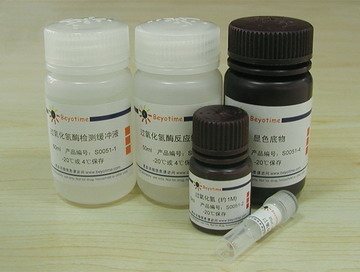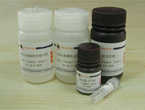|
|||||||||
产品简介
产品简介:
| 产品编号 | 产品名称 | 产品包装 | 产品价格 |
| S0051 | 过氧化氢酶检测试剂盒 | 100次 | 298.00元 |
过氧化氢酶检测试剂盒(Catalase Assay Kit)是一种简单易行的通过显色反应来检测细胞、组织或其它样品中过氧化氢酶(Catalase)活性的试剂盒。在过氧化氢相对比较充足的情况下,过氧化氢酶可以催化过氧化氢产生水和氧气。残余的过氧化氢在过氧化物酶(Peroxidase)的催化下可以氧化生色底物,产生红色的产物(N-(4-antipyryl)-3-chloro-5-sulfonate-p-benzoquinonemonoimine),最大吸收波长为520nm。用过氧化氢标准品,制作标准曲线,这样就可以计算出样品中的过氧化氢酶在单位时间单位体积内催化了多少量的过氧化氢转变为水和氧气,从而可以计算出样品中过氧化氢酶的酶活力。
过氧化氢酶分布非常广泛。在肝脏、肾脏和红细胞中,过氧化氢酶的水平非常高,是清除能导致氧化损伤的过氧化氢的主要场所。
过氧化氢酶的活性也可以用紫外分光光度计测定A240,但蛋白质或其它组份在A240附近都有比较强的吸收,会对测定产生严重干扰。因此,用紫外法测定过氧化氢酶的活性,比较适合纯化的过氧化氢酶。本试剂盒通过检测A520来测定过氧化物酶催化下由过氧化氢氧化生色底物产生的红色产物,受干扰的因素小,检测灵敏度高,可以检测出低达1U/ml的过氧化氢酶。
本试剂盒可以检测全血、红细胞裂解产物、血清、组织匀浆产物、细胞裂解产物等生物样品中的过氧化氢酶的活性。一个试剂盒共可以进行100次检测。
包装清单:
产品编号 |
产品名称 |
包装 |
S0051-1 |
过氧化氢酶检测缓冲液 |
60ml |
S0051-2 |
过氧化氢 (约1M) |
5ml |
S0051-3 |
过氧化氢酶反应终止液 |
50ml |
S0051-4 |
显色底物 |
20ml |
S0051-5 |
过氧化物酶 |
20μl |
— |
说明书 |
1份 |
保存条件:
-20℃保存,一年有效。 过氧化氢酶检测缓冲液和过氧化氢酶反应终止液也可以4℃保存。
注意事项:
待测的过氧化氢酶样品,无论是纯的过氧化氢酶还是细胞或组织裂解产物,在4℃通常可以保存1
周,-70℃可以长期保存,但-20℃保存后过氧化氢酶的活力会显著下降。
在检测过程中加入过氧化氢酶反应终止液后15分钟内需开始显色反应。
过氧化氢不太稳定,精确的过氧化氢浓度需参考本说明书中的方法进行测定。
如需对样品中的过氧化氢酶活力进行精确定量,需自备蛋白浓度测定试剂盒。例如可以选购碧云天
生产的BCA蛋白浓度测定试剂盒(P0009/P0010/P0010S/P0011/P0012/P0012S)测定样品的蛋白浓度。
为了您的安全和健康,请穿实验服并戴一次性手套操作。
使用说明
使用说明:
1. 试剂盒的准备工作:
a. 配制250mM过氧化氢溶液。本试剂盒提供的过氧化氢浓度约为1M。由于过氧化氢不是非常稳定,使用
前需自行测定过氧化氢的实际浓度。把浓度约为1M的过氧化氢用本试剂盒提供的过氧化氢酶检测缓
冲液稀释100倍,使过氧化氢的浓度约为10mM。测定A240。
过氧化氢浓度(mM)=22.94 X A240
从而计算出本试剂盒提供的过氧化氢的实际浓度。然后再根据实际的过氧化氢浓度配制250mM过氧化
氢溶液。
b. 配制5mM过氧化氢溶液。根据测定得到的实际过氧化氢浓度配制5mM过氧化氢溶液。
c. 配制显色工作液。在冰浴上溶解显色底物,适当分装后再使用,尽量避免反复冻融。其它试剂放置
在冰浴上备用。取适当量的过氧化物酶,按照1:1000的比例用显色底物稀释,配制成显色工作液。
例如取5μl过氧化物酶,加入5ml显色底物,混匀即得到5ml显色工作液。
2. 样品的准备:
用适当的裂解液裂解细胞或组织(可以使用碧云天生产的Western及IP细胞裂解液(P0013)进行裂解。
用本试剂盒提供的过氧化氢酶检测缓冲液稀释样品,裂解好的样品至少加入等体积的过氧化氢酶检
测缓冲液进行稀释。具体的稀释倍数可以参考表1。
表1
样品名称 |
蛋白浓度 |
检测时的样品使用量 |
反应时间 |
A520 (空白对照-样品-) |
Blank |
- |
- |
- |
1.17 (空白对照实测值) |
Human red blood cell lysate |
0.2mg/ml |
4μl |
2min |
0.46 |
Rat liver lysate |
0.3mg/ml |
7.5μl |
1min |
0.57 |
Rat kidney lysate |
0.3mg/ml |
7.5μl |
3min |
0.42 |
Rat spleen lysate |
0.3mg/ml |
7.5μl |
3min |
0.16 |
Rat brain lysate |
0.3mg/ml |
15μl |
3min |
0.021 |
HepG2 lysate |
2.0mg/ml |
3μl |
3min |
0.32 |
Jurkat lysate |
2.0mg/ml |
3μl |
3min |
0.46 |
说明:表中的数据仅供参考,实际测定值由于检测体系的不同等可能与参考值之间存在20-50%的误
差。对于相同的样品,同样的实验体系,测得的A520值和表1相比可能会有较大差异。如果实验体系
不同,例如测得蛋白浓度的方法不同,使用的检测波长不同等,测得的A520值和我们提供的参考数
值相比可能会有更大的差异。对于表中没有列出的样品,可以参考表中的类似样品进行检测,然后
再根据检测结果适当调整蛋白浓度和样品使用量,或反应时间。通常对于完全未知的样品,可以对
样品进行1、10、20和50倍稀释,然后各取10μl,反应1分钟。样品稀释后的浓度,最好可以使反应
体系中的过氧化氢在反应1-5分钟后减少30-50%左右,这时的检测结果更加精确。
a. 细胞样品的准备。可以用碧云天生产的Western及IP细胞裂解液(P0013)参考相应的说明裂解细胞样
品。
b. 组织样品的准备。可以用碧云天生产的Western及IP细胞裂解液(P0013)参考相应的说明裂解组织样
品。
c. 全血样品的准备。收集全血(whole blood)至一抗凝管内,颠倒混匀。取100微升全血冻融一次,用
过氧化氢酶检测缓冲液稀释1000倍后进行后续检测。
d. 红细胞裂解液的准备。用抗凝管收集血液,颠倒混匀。取至少500微升全血4℃ 2500g离心5分钟。弃
上清,沉淀用冰冷的生理盐水(0.9%氯化钠)洗涤3次。用约5倍细胞体积的冰冷的去离子水,例如
Milli-Q纯水,重悬细胞沉淀,冰浴10分钟。使用前用过氧化氢酶检测缓冲液稀释400倍后进行后续
检测。
3. 标准曲线测定:
a. 取0、12.5、25、50或75微升配制好的5mM过氧化氢溶液至1.5ml或0.5ml塑料离心管中,分别加入过
氧化氢酶检测缓冲液至最后体积为100微升,混匀。
b. 各取4微升,加入到96孔板中的一个孔内。加入200μl显色工作液。25℃至少孵育15分钟后测定
A520,但孵育时间不宜超过45分钟。(注:本步骤可以和样品测定步骤中的最后一步同时进行。)
4. 样品测定:
表2
|
空白对照 (blank) |
样品 (sample) |
样品体积 |
0 μl |
x μl |
过氧化氢酶检测缓冲液 |
40 μl |
40-x μl |
250mM过氧化氢溶液 |
10 μl |
10 μl |
a. 参考表2,取x微升(0-40微升)样品至1.5ml塑料离心管中,加入过氧化氢酶检测缓冲液至体积为40微
升(即加入40-x微升过氧化氢酶检测缓冲液),混匀。再加入10微升250mM过氧化氢溶液,用移液器迅
速混匀。参考表1,25℃反应1-5分钟。
b. 加入450微升过氧化氢酶反应终止液,颠倒混匀或Vortex混匀以终止反应。需在终止反应后15分钟
内完成下面的步骤c和步骤d。
c. 在一洁净的塑料离心管内加入40微升过氧化氢酶检测缓冲液,再加入10微升已终止并混匀的上述
反应体系,混匀。
d. 从上一步骤的50微升体系中取10微升加入到96孔板中的一个孔内。加入200微升显色工作液。
e. 25℃至少孵育15分钟后测定A520,但孵育时间不宜超过45分钟。
5. 样品中过氧化氢酶酶活力的计算:
a. 计算出标准曲线。A520=k[过氧化氢微摩尔数]+b,由标准曲线计算出k和b的值。
b. 计算出样品中残余的过氧化氢摩尔数。
残余过氧化氢微摩尔数=(A520-b)/k
c. 过氧化氢酶酶活力单位的定义:1个酶活力单位(1 unit)在25℃,pH7.0的条件下,在1分钟内可以催
化分解1微摩尔过氧化氢。
d1. 对于细胞或组织样品的过氧化氢酶活力计算:
[样品过氧化氢酶酶活力]=[消耗过氧化氢微摩尔数] X[稀释倍数]/([反应分钟数]X[样品体积] X
[蛋白浓度])
[样品过氧化氢酶酶活力]的单位为units/mg蛋白
[消耗过氧化氢摩尔数]=[空白对照残余过氧化氢微摩尔数]-[样品残余过氧化氢微摩尔数]
[稀释倍数]=250
[反应分钟数]即为实际的反应分钟数
[样品体积]为表2中的X微升,以毫升来表示即为X/1000毫升。
[蛋白浓度]为取X微升样品时,样品中的蛋白浓度,单位为mg/ml。
d2. 对于血浆等液体样品的过氧化氢酶活力计算:
[样品过氧化氢酶酶活力]=[消耗过氧化氢微摩尔数] X[稀释倍数]/([反应分钟数]X[样品体积])
[样品过氧化氢酶酶活力]的单位为units/ml样品
产品图片

相关产品
相关论文
使用本产品的相关论文:
1. Wang DW, Hu YL, Liu YJ, Lin ZP.
Studies on the Function of Vitreoscilla Hemoglobin Gene in
Improving Sur factin
Producing Rate of Bacillus subtilis.
Biotechnology bulletin.2007 No.5.
2. He Z, Sun X, Mei G, Yu S, Li N.
Nonclassical secretion of human catalase on the surface of CHO cells is more efficient
than classical secretion.
Cell Biol Int. 2008 Apr;32(4):367-73.
3. He Z, Yu S, Mei G, Zheng M, Wang M, Dai Y, Tang B, Li N.
Maternally transmitted milk containing recombinant human catalase provides protection
against oxidation for mouse offspring during lactation.
Free Radic Biol Med. 2008 Oct 15;45(8):1135-42.
4. Zhu M, Gu F, Shi J, Hu J, Hu Y, Zhao Z.
Increased oxidative stress and astrogliosis responses in conditional double-knockout
mice of Alzheimer-like presenilin-1 and presenilin-2.
Free Radic Biol Med. 2008 Nov 15;45(10):1493-9.
5. Wang XZ, Liu SS, Sun Y, Wu JY, Zhou YL, Zhang JH.
Beta-cypermethrin impairs reproductive function in male mice by inducing oxidative
stress.
Theriogenology. 2009 Sep 15;72(5):599-611.
6. Qian J, Jiang F, Wang B, Yu Y, Zhang X, Yin Z, Liu C.
Ophiopogonin D prevents H2O2-induced injury in primary human umbilical vein endothelial
cells.
7. Huang X, Zhuang J, Teng X, Li L, Chen D, Yan X, Tang F.
The promotion of human malignant melanoma growth by mesoporous silica nanoparticles
through decreased reactive oxygen species.
Biomaterials. 2010;31(24):6142-53. Epub 2010 May 26.
8. Zhao G, Yao-Yue C, Qin GW, Guo LH.
Luteolin from Purple Perilla mitigates ROS insult particularly in primary neurons.
Neurobiol Aging. 2010.
9. Chen Y, Chang L, Li W, Rong Z, Liu W, Shan R, Pan R.
Thioredoxin protects fetal type II epithelial cells from hyperoxia-induced injury.
Pediatr Pulmonol. 2010 Dec;45(12):1192-200.
10.Liu XM, Zhou Q, Xu SZ, Wakamatsu K, Lei TC.
Maintenance of immune hyporesponsiveness to melanosomal proteins by DHICA-mediated
antioxidation: Possible implications for autoimmune vitiligo.
Free Radic Biol Med. 2011 May 1;50(9):1177-85.
11.Zhou J, Li Y, Yan G, Bu Q, Lv L, Yang Y, Zhao J, Shao X, Deng Y, Zhu R, Zhao Y, Cen X.
Protective role of taurine against morphine-induced neurotoxicity in C6 cells via
inhibition ofoxidative stress.
Neurotox Res. 2011 Nov;20(4):334-42. Epub 2011 May 25.
12.Min L, He S, Chen Q, Peng F, Peng H, Xie M.
Comparative proteomic analysis of cellular response of human airway epithelial cells
(A549) tobenzo(a)pyrene.
Toxicol Mech Methods. 2011 Jun;21(5):374-82. Epub 2011 Mar 21.
13.Yang L, Zheng XL, Sun H, Zhong YJ, Wang Q, He HN, Shi XW, Zhou B, Li JK, Lin Y,
Zhang L, Wang X.
Catalase suppression-mediated H(2)O(2) accumulation in cancer cells by wogonin
effectively blocks tumor necrosis factor-induced NF-κB activation and sensitizes
apoptosis.
Cancer Sci. 2011 Apr;102(4):870-6.
14.Fan J, Yin JJ, Ning B, Wu X, Hu Y, Ferrari M, Anderson GJ, Wei J, Zhao Y, Nie G.
Direct evidence for catalase and peroxidase activities of ferritin-platinum
nanoparticles.
Biomaterials. 2011 Feb;32(6):1611-8. Epub 2010 Nov 26.
15.Zhang Y, Fu D, Yu F, Liu Q, Yu Z.
Two catalase homologs are involved in host protection against bacterial infection and
oxidative stress in Crassostrea hongkongensis.
Fish Shellfish Immunol. 2011 Dec;31(6):894-903. Epub 2011 Aug 18.
16.Li W, Wu Y, Ren C, Lu Y, Gao Y, Zheng X, Zhang C.
The activity of recombinant human neuroglobin as an antioxidant and free radical
scavenger.
Proteins. 2011 Jan;79(1):115-25.
17.Wang J, Sun P, Bao Y, Liu J, An L.
Cytotoxicity of single-walled carbon nanotubes on PC12 cells.
Toxicol In Vitro. 2011 Feb;25(1):242-50.
18.Shi X, Gu A, Ji G, Li Y, Di J, Jin J, Hu F, Long Y, Xia Y, Lu C, Song L, Wang S, Wang X.
Developmental toxicity of cypermethrin in embryo-larval stages of zebrafish.
Chemosphere. 2011 Oct;85(6):1010-6.
19.Wang S, Duan Y, Zeng Q, Zhao Z, Wang X.
[D-Ala2, D-Leu5]-Enkephalin (Dadle) Reduces Inflammation Responses after Transient
Global Ischemia.
Advanced Materials Research. Volume 345,343-348,September 2011.
20.Deng X, Wu K, Wan J, Li L, Jiang R, Jia M, Jing Y, Zhang L.
Aminotriazole attenuated carbon tetrachloride-induced oxidative liver injury in mice.
Food Chem Toxicol. 2012 Jun 8;50(9):3073-3078.
21.Cao L, Li Z, Zhang R, Wu Y, Li W, Cao Z.
StCT2, a new antibacterial peptide characterized from the venom of the scorpion
Scorpiopstibetanus.
Peptides. 2012 Aug;36(2):213-20. Epub 2012 Apr 27.
22.Wang H, Meng XL, Xu JP, Wang J, Wang H, Ma CW.
Production, purification, and characterization of the cecropin from Plutella xylostella,
pxCECA1using an intein-induced self-cleavable system in Escherichia coli.
Appl Microbiol Biotechnol. 2012 May;94(4):1031-9.
23.Shao X, Hu Z, Hu C, Bu Q, Yan G, Deng P, Lv L, Wu D, Deng Y, Zhao J, Zhu R, Li Y, Li H,
Xu Y, Yang H, Zhao Y, Cen X.
Taurine protects methamphetamine-induced developmental angiogenesis defect
throughantioxidant mechanism.
Toxicol Appl Pharmacol. 2012 May 1;260(3):260-70.
24.Li NS, Luo XJ, Dai Z, Liu B, Zhang YS, Yang ZC, Peng J.
Beneficial effects of capsiate on ethanol-induced mucosal injury in rats are related to
stimulationof calcitonin gene-related Peptide release.
Planta Med. 2012 Jan;78(1):24-30. Epub 2011 Sep 16.
25.Liu Z, Li S, Cai Y, Wang A, He Q, Zheng C, Zhao T, Ding X, Zhou X.
Manganese superoxide dismutase induces migration and invasion of tongue squamous cell
carcinoma via H2O2-dependent Snail signaling.
Free Radic Biol Med. 2012 Jul 1;53(1):44-50.
26.Cao L, Dai C, Li Z, Fan Z, Song Y, Wu Y, Cao Z, Li W.
Antibacterial activity and mechanism of a scorpion venom Peptide derivative in vitro and
in vivo.
PLoS One. 2012;7(7):e40135. Epub 2012 Jul 5.
27.Liu JH, Qi ZM, Huang Q, Wei XL,Ke ZG, Fang YS, Tian YC, Yu ZG.
Study of energetic-particle-irradiation induced biological effect on Rhizopus oryzae
through Synchrotron-FTIR micro-spectroscopy.
Journal of Molecular Structure,2012Jan,1031(16),1-8.
28.Li XC, Xing YZ, Jiang X, Qiao J,Tan HL, Zhou B.
Identification And Characterization Of The Catalase Gene Pycat From The Red Alga Pyropia
Yezoensis (Bangiales, Rhodophyta) 1.
Journal of Phycology,2012Jun,48(3),664-669.
29.Wang J, Sun P, Bao Y, Dou B, Song D, Li Y.
Vitamin E renders protection to PC12 cells against oxidative damage and apoptosis
induced bysingle-walled carbon nanotubes.
Toxicol In Vitro. 2012 Feb;26(1):32-41.
30.Sun WH, Liu F, Chen Y, Zhu YC.
Hydrogen sulfide decreases the levels of ROS by inhibiting mitochondrial complex IV
andincreasing SOD activities in cardiomyocytes under ischemia/reperfusion.
Biochem Biophys Res Commun. 2012 May 4;421(2):164-9.
31.Zhou T, Zong R, Zhang Z, Zhu C, Pan F, Xiao X, Liu Z, He H, Ma JX, Liu Z, Zhou Y.
SERPINA3K Protects against Oxidative Stress via Modulating ROS Generation/Degradation
andKEAP1-NRF2 Pathway in the Corneal Epithelium.
Invest Ophthalmol Vis Sci. 2012 Jul 27;53(8):5033-43. Print 2012.
32.Tie L, Yang HQ, An Y, Liu SQ, Han J, Xu Y, Hu M, Li WD, Chen AF, Lin ZB, Li XJ.
Ganoderma lucidum polysaccharide accelerates refractory wound healing by inhibition of
mitochondrial oxidativestress in type 1 diabetes.
Cell Physiol Biochem. 2012;29(3-4):583-94. doi: 10.1159/000338512. Epub 2012 Apr 3.
33.Shi H, Wang Y, Cheng Z, Ye T, Chan Z.
Analysis of natural variation in bermudagrass (Cynodon dactylon) reveals physiological
responses underlyingdrought tolerance.
PLoS One. 2012;7(12):e53422. doi: 10.1371/journal.pone.0053422. Epub 2012 Dec 28.
34.Zheng J, Yang B, Yu Y, Chen Q, Huang T, Li D.
Ganoderma lucidum polysaccharides exert anti-hyperglycemic effect on
streptozotocin-induced diabetic rats through affecting β-cells.
Comb Chem High Throughput Screen. 2012 Aug;15(7):542-50.
35.Ren C, Li Y, Han R, Gao D, Li W, Shi J, Hoogewijs D, Braeckman BP, De Henau S, Lu Y,
Qu W, Gao Y, Wu Y, Li Z, Liu H, Wang Z, Zhang C.
GLB-13 is associated with oxidative stress resistance in caenorhabditis elegans.
IUBMB Life. 2013 May;65(5):423-34. doi: 10.1002/iub.1132. Epub 2013 Mar 18.
36.Sun P, Chen JY, Li J, Sun MR, Mo WC, Liu KL, Meng YY, Liu Y, Wang F, He RQ, Hua Q.
The protective effect of geniposide on human neuroblastoma cells in the presence of
formaldehyde.
BMC Complement Altern Med. 2013 Jul 1;13:152. doi: 10.1186/1472-6882-13-152.
37.Wang X, Zhang Y, Li T, Tian W, Zhang Q, Cheng Y.
Generation 9 polyamidoamine dendrimer encapsulated platinum nanoparticle mimics catalase
size, shape, andcatalytic activity.
Langmuir. 2013 Apr 30;29(17):5262-70. doi: 10.1021/la3046077. Epub 2013 Apr 15.
38.Wang M, Wang L, Zhou Z, Gao Y, Wang L, Shi X, Gai Y, Mu C, Song L.
The molecular characterization of a catalase from Chinese mitten crab Eriocheir
sinensis.
Int J Immunogenet. 2013 Jun;40(3):230-40. doi: 10.1111/iji.12019. Epub 2012 Nov 22.
39.Shi H, Ye T, Wang Y, Chan Z.
Arabidopsis ALTERED MERISTEM PROGRAM 1 negatively modulates plant responses to abscisic
acid anddehydration stress.
Plant Physiol Biochem. 2013 Apr 3;67C:209-216. doi: 10.1016/j.plaphy.2013.03.016.
40.Zhang H, Shao D, Wu Y, Dai B, Cai C, Fang W, Ye B, Zhang Y, liu J, Jia X.
Regulation of nodularin-induced apoptosis by epigallocatechin-3-gallate on fish
lymphocytes in vitro.
Fish Shellfish Immunol. 2013 May;34(5):1085-93. doi: 10.1016/j.fsi.2013.01.012.
Epub 2013 Feb 9.
41.Yu CH, Liu ZY, Sun W, Li YJ, Zhang DS, Pan RT, Sun ZL.
Effect of Danofloxacin on Reactive Oxygen Species Production, Lipid Peroxidation and
Antioxidant EnzymeActivities in Kidney Tubular Epithelial Cell Line, LLC-PK1.
Basic Clin Pharmacol Toxicol. 2013 Jul 15. doi: 10.1111/bcpt.12110.
苏ICP备06009238号 |
